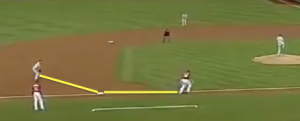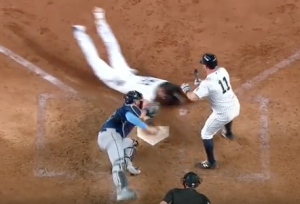Keys to Stealing Home
By Matt Talarico, StealBases.com
Originally I wanted to do an entry on quick tips to steal home, but as I think about it I believe it can be more beneficial to include leading off at third and stealing home. Often the leadoff is overlooked. Most teams really concentrate on leadoff work at 1st and 2nd but then neglect third outside of a few pointers. If done correctly, the leadoff at 3B can be crucial in adding another run so we should have sound logic when working there.
PART I – THE LEADOFF
First, I’d like to talk about the end goal of the leadoff. The reason why we leadoff third base is to get closer to home but also to get momentum to home on the release of the pitch. As the pitch is entering the zone of contact you should be maxed out in your leadoff and anticipating contact.
Our fundamentals are a little different because we like to use a bit more of a walking lead, meaning we carry more momentum during the delivery of the pitcher. We do this in foul territory and we always return in fair territory. We lead in foul territory in case we get hit with a foul ball we won’t be called out and we return in fair territory to make a throw more difficult for the catcher.
LEADOFF DISTANCES
We also do not use exact footwork here because it is very dependent on where the third baseman has decided to play. We are going to get as far as he will let us get. There really is no excuse for a third base pickoff. This only comes when you aren’t paying attention to the defense… if he is outside of your range then you should always be able to win a race to the bag.

READS OFF THE BAT
We use 3 reads at third depending on the situation and what the head coach feels like the team needs. It is also important to emphasize we ALWAYS return on a line drive. You will still score if you return and the ball gets through… so we have to make this a habit that is worked on during practice.
First is reading the ball angle off of the bat – if we see the ball going down or “down angle” then we will go. If the leadoff is done correctly there should be no hesitation – making it difficult to get us out at home on a ground ball.
The second read would be seeing the ball through the infield. Again, our leadoff should be the same as situation 1 but we are holding our position until we see a situation that allows us to score in an obvious way.
The final situation would be a hybrid of the two. We are down angle with exceptions. So down angle except to 3B would be an example. You can make this situation whatever you want as the 3B coach based on the other team.
THE RETURN TO THIRD
The most critical part of being a good runner at third base is to understand where you are vulnerable. When I am at the end of my leadoff and anticipating contact I am also at my most vulnerable point. You MUST know how to return on every single pitch. We talk about gaining ground. This is very much like our lateral acceleration drills in the steal start technique section. That is why we always work on accelerating BOTH ways. The key is to really punch your right leg back to third base. We really want to gain ground in our first two steps.
(Check out more of Jerry Weinstein’s instructional videos on his youtube page here!)
The mindset should be to always anticipate the ball being hit on the ground or a semi-passed ball but to also anticipate a back pick after every pitch. This makes you very hard to back pick.
*Tip – In case of a throw to third it is usually smart to NOT slide back to the base. If you are returning in fair territory and tall then it is a difficult throw that can hit you in the back vs. be a perfect throw on the bag.
PART II – STEALING HOME
So, now that we are comfortable getting a lead and understanding what to do off the bat lets get into the good stuff…
We can do this a few ways. Your most common method is a first and third situation and I am not going to get into that on this blog. I would like to stick to 3 methods of stealing home.
Method 1: On the catcher’s return throw to the pitcher
Method 2: The straight steal of home
Method 3: The early break
Both of these methods rely on what the other team gives you. You cannot force a steal of home like you can when stealing second. You have to look for weaknesses and openings.
Before going through these it is probably important that I mention there are times to do this and times to be patient. For example, if there are no outs then you probably should pass- chances are you are going to score anyway. Wait until the timing is right!
Method 1: Running on the catcher’s throw
I am looking for a few different things and to see these I have to pay attention to runners at third before me.
Key 1 – I want to see lazy, lollipop throws back to the pitcher.
Key 2 – I would prefer a pitcher who throws with a longer arm swing vs. someone who can sling it – typically they have a more difficult time getting rid of it quick.
Key 3 – A catcher who throws soft from his knees (this doesn’t have to be the case but is nice to have)
Key 4 – 3rd baseman is playing with decent range, allowing that leadoff to be stretched a bit.
To get this to work it is important that all of your leadoffs before have a good return to the base – you don’t want to give the catcher any sense he can back pick. When you decide the pitch you want you simply will hold your ground vs. returning as mentioned before. The goal is to leave before the ball leaves his hand but past the point to where the catcher can hold the ball. This will give the catcher the feeling of helplessness, as the pitcher has to wait for the lollipop to come back down and find a way to return it.
It can also be beneficial if you know your times to the plate from certain distances. This will allow you to use a stopwatch from the dugout and have a good idea if the math adds up before going out and risking it.
Method 2: The straight steal
Key 1: What about this pitcher makes you think this will work?
- Does he have a slow windup?
- Does he have a habit you can exploit?
You have to be intelligent, because we cannot make a poor out out when we are just 90′ from scoring. We have stolen home off of righties out of the windup – which is a bit unconventional – because he had a habit of looking down and breathing before starting. Our runner timed this up and took home (actually causing a balk). So it isn’t an exact science but you do need to have logic before trying.
Key 2: Where is the 3B playing?
- As you can see this is a very important factor. If he’s playing a step from the back it is very difficult to run because the pitcher has the option of a pickoff. With shifting being popular it really opens up big leadoffs at third. This can make a pitcher with a windup that is just a bit slow a candidate to steal off of. So pay attention!
If we get a leadoff that is going to give a shot we are going to try and get a great break off the pitchers first movement. Remember, if the third baseman has some depth then we would rather break a bit early and have to get back vs. leaving late and getting thrown out.
Tip: Try adjusting your leadoff for that pitch. When I mentioned our leadoffs in the earlier section I talked about staying in foul territory. If I am attempting to steal home my target will more than likely be the front of the plate and not the back. You want to cheat as much as possible so for that one pitch scoot up in the line to give yourself a straight line to the front of the plate to avoid the catcher. The clip above demonstrates the adjustment the runner had to make to get to the front of the plate… this takes time.

Method 3: The Early Break
The last method we will cover is the early break from third. This would mean that before the pitcher picks up his front foot we are taking off.
Key 1: The pitcher must have a habit of taking focus off of the runner too soon.
Tip: It is also important to mention to always slide with your face away from the ball. So if the ball is coming from the pitcher then look at the catcher. If the ball is coming from the catcher (like a passed ball) look at the pitcher.
Key 2: You must be able to get a good distance off of 3B.
This is going to be almost 100% dependent on the third baseman’s depth. He has to be far off the bag allowing you to get quite a way down the line. You are hoping for 1 of 2 things – a balk or catching him off guard trying to win the race to the plate.
Stealing home is more about realizing where the opportunities are. If players learn these opportunities and jump on them then you might be able to get a couple in a year. We never force this issue but stealing home doesn’t only score a run but is usually a momentum swing as well. Start looking for these opportunities and looking to be more aggressive!
For more information please check out the rest of the system. There is far more information that can add to your game. Join today by clicking here!
Please check back for more blog updates soon!

